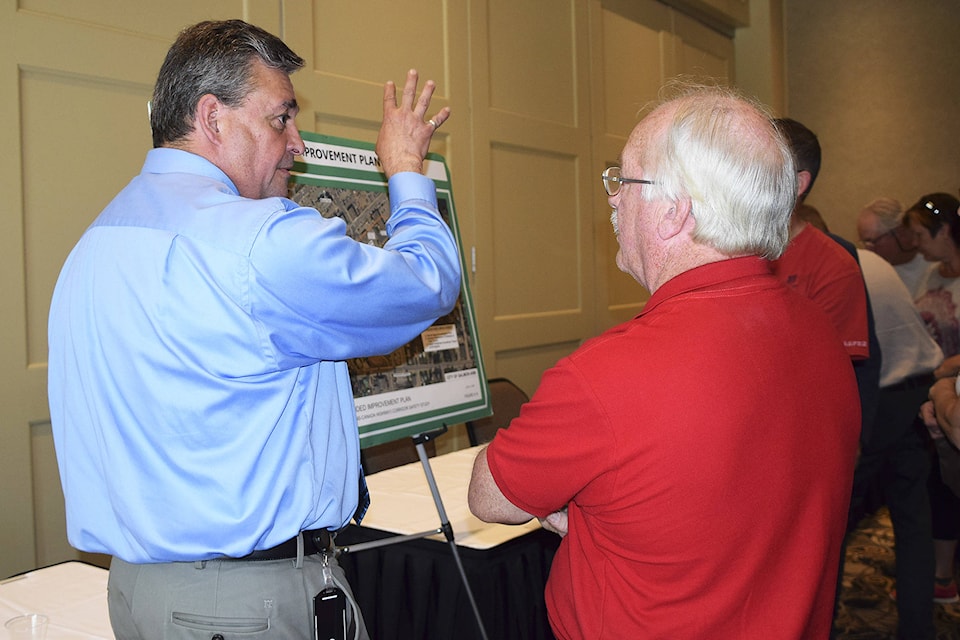Not everyone agrees with proposed changes for the Trans-Canada Highway through Salmon Arm’s downtown corridor, but the consultation has been appreciated.
The City of Salmon Arm, the Insurance Corporation of BC and the provincial Ministry of Transportation and Infrastructure held an open house Thursday afternoon for the public to look over and express feedback on a 2013 traffic study. More than 100 people attended.
When the study was first presented, dissatisfaction from the business community prompted its shelving.
However, in the wake of a traffic study by the Salmon Arm Chamber of Commerce and accidents along the corridor, the study was removed from the shelf for a second look.
Carl Bannister, the city’s chief administrator, said he heard some “pretty constructive input” at the open house, “constructive in terms of what changes could be made for the better.”
David Dean, a road safety engineer with ICBC, noted: “We have competing objectives with the highway and a downtown urban setting, and I think the consultant has done a good job identifying the issues that arise with those competing objectives and a lot of the solutions that he has proposed have really addressed the issues that are identified.”
Although the city and ICBC did not hesitate to be interviewed, the MOTI spokesperson said he would not comment because the province is still in the interregnum period, the period between when the provincial writ is dropped and a new government is elected.
Dean said both ICBC and MOTI have put aside funds, so the changes could be undertaken this year.
The deadline for input has been extended by council to July 2. Later in July, staff will provide a report to council, which is expected to make a decision on how to proceed.
City staff say the anticipated funding split for the first phase, Alexander Avenue to Sixth Street, will be $70,000 from the city, $70,000 from MOTI and $50,000 from ICBC.
Staff Sgt. Scott West of Salmon Arm RCMP remarked: “Any change in traffic flow or traffic structure on Highway #1 in the downtown area would be positive if it reduces collisions or injuries that result from those.”
Stu Bradford, co-owner of the Barley Station Brewpub – which offers a front row view of the corner of the Trans-Canada Highway and Shuswap Street – has been an outspoken proponent for changes to the highway.
He approves of the process.
“I think the timing is right. We have to do something about it and if we all cooperate together and get everybody involved, we’ll get the results that will make the town safer. I’m glad to see it back on the table.
Does he favour any particular scenario?
“Not really, I think the powers-that-be have all the information they need to do what’s going to be the best safety-wise and traffic-wise for the city. I’m not a traffic planner – I’m just glad something’s going to be done to try and make this traffic corridor safer for the community. Not everybody’s going to be happy with what may or may not come up, but you know, we adapt to those things. You change a street light, you grumble about it for a while, but then you get used to it. It’s progress, we have to do something.
“It’s really nice that we get a chance to get together and talk about it, rather than hearing about it later. Have the discussion period ahead of time, then everybody’s happy, they’ve had a say.
Cindy Derkaz says that overall, she supports the changes.
“I think there has been an attempt to address the safety concerns of traffic going through town and I support moving the traffic light. I think it does add some additional pressures, particularly in front of the post office, and some things will need to be addressed, but I think the city streets can be tweaked to address an additional stresses.”
Business owner Ian Wickett said he doesn’t think the study addresses the true problems.
“The issue is that people treat it as the Trans-Canada Highway rather than a City of Salmon Arm street, and that results in a lot of conflicts in expectations.”
He said the changes need to transform the roadway clearly into an urban street that requires urban driving, with drivers stopping and turning and pedestrians walking.
While some proposed changes will do this, he would also like options considered such as a gateway or arch, perhaps a lowered speed limit from 50 to 45 km/h, and a technique called crowding where vegetation such as hedges alongside make the road seem narrower and slows drivers. He said grooves or rumble strips approaching intersections would signal to drivers they may have to stop.
In the long term, he said a bypass seems prohibitively expense, but a tunnel underneath the existing road could separate through traffic from local traffic.
Resident Calvin Van Buskirk said the plan looks like a viable stopgap, for now, “until we can get the trucks out of town. It looks pretty reasonable to me. I do like the idea of trying maybe to get the truckers to use the left lane, if that’s a viable thing; that’s where a lot of the collisions occur, from what I understand.”
A cursory summary of the 2013 ICBC study lists a number of scenarios, but favours what it calls Scenario 5 for traffic operation and road safety, which would restrict left turns from 6th Street southbound.
The modifications to Highway 1 intersections are as follows: a signal with a long westbound left-turn bay at Shuswap Street; a stop controlled ‘right-in-right-out’ at McLeod Street; a signal with a long eastbound left-turn bay at Alexander Street; a stop controlled ‘right-in-right-out’ at Ross Street; a signal at Fourth Street; and a stop controlled Sixth Street with restricted southbound left turns. Scenario 5 includes extending the Highway 1 median at McLeod Street, relocating the signal from Ross Street to Fourth Street, and extending the highway median at Fourth Street.
